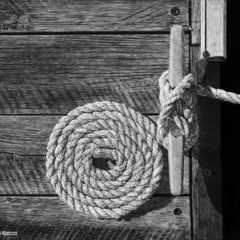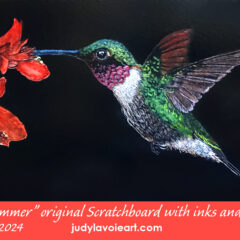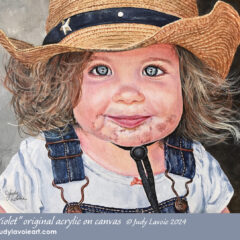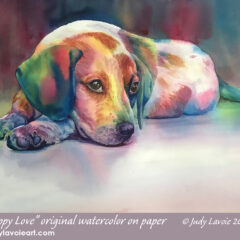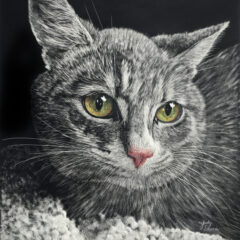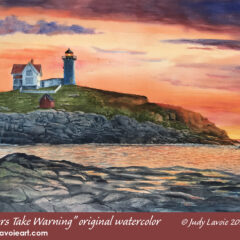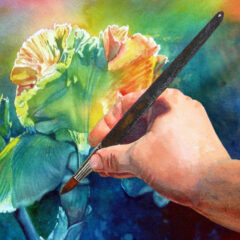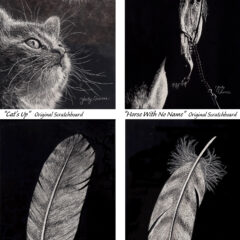 |
| Some of my reference photos |

Painting “Elles Tobacco Planter” has been on my mind for a long time. I have taken oodles of reference photos of this quirky piece of farm equipment, from various angles, in different seasons, close up and distant. The planter sits on the edge of the drive into the farm of my friends Carolyn and Mitch. This is an old 2-man tobacco planter which Mitch used long ago. (Read below how it is used). There are actually two tractor seats, although one is a bit hidden in the angle I’ve chosen. I love the rusted metal, peeling paint, and the faded lettering “Elles” on the boxes which held the tobacco plants.
I struggled with how to compose this painting, and that’s what kept me from getting started for a long time. The actual setting, as you can see from my reference photos, is very busy visually – piles of leaves and lots of trees. I wanted the machinery to be the focal point, not to be lost in the woods. Finally it occurred to me that by creating a winter scene, with a bit of snow on the ground, I could use the white areas to contrast with my main character. Also, by inventing a landscape with a distant mountain view and just a few trees, I could create more of a story. You’ll notice from my main reference photo that I also took the liberty of relocating the big tree, moving it a few feet away from the planter, which isolates it and gives it even more prominence. As a painter, you can move mountains! This is actually the first painting I have done with a distant mountain view. It’s very much like the beautiful view of the Smoky Mountains from my own front porch.
As with many landscapes, I worked this painting from the most distant elements to the front. My photos of the work in progress shows how each section was layered over the previous one. This is a bit tricky when working with watercolors, since their transparency prohibits a light area from covering over a dark area. This is one of the challenges I love in painting with watercolors. Conversely, when I painted “Let It Snow,” I worked with opaque acrylics, so I could paint one color over another. For Elles Tobacco Planter I had sketched the major elements in my painting first, and you can see how I “painted around” the big tree and the tank. Remember, in a traditional transparent watercolor painting, the white areas are unpainted paper.
One way to make items appear as if they are far away is to make them lighter, less contrasty, and more subdued in color than things closer… as our brains would process into the spacial relationship if we were viewing such a scene. I was taught to call this atmospheric perspective. “Aerial perspective equals atmosphere…. Light, color, detail, edges and contrast weaken as they flow into the distance. All living creatures subliminally understand this.” – artist Harley Brown. I like to use a really heavyweight watercolor paper, so I can wet it and rub away some of the pigment if I get too bold with my colors, as I tend to do! Or when I decide to add things I hadn’t planned, like add the smaller tree and the fence post to the left. Thick D’Arches 300 lb. watercolor paper is my preference, with a rough surface (cold press), and it holds up well to my abuse. I can even use an x-acto knife to scratch away the top layer, if I get a spot on a white area that shouldn’t be there, for example.
For this painting, I wanted to do a lot of blending of colors, much of it right on the paper, and I chose a rainbow palette of eight watercolor paints: Winsor Yellow, Yellow Ochre, Cadmium Yellow Deep, Vermillion, Permanent Red, Burnt Sienna, Cerulean, and Indigo. These hues tend to be grainy pigments, as opposed to fine dye-type stains. Such paint particles sometimes separate a bit from each other when mixed, so they create interesting effects on the paper. There were no green paints in my chosen palette, even though the main character, the tobacco planter, is green. I wanted to mix all my greens, and create variety and interest this way. My quick little color mixing swatch convinced me that my chosen colors give me the look I had in my brain.
 To add some additional horizontal elements to balance with the stark verticals of the trees, I decided to add some fencing in the near background. Many years ago I formed an intimate relationship with barbed wire when we purchased the land we now live on, which was surrounded by an old barbed wire fence in much need of repair. Back where I grew up in New England, the field stones dug out of the cleared land were stacked to make stone walls along the borders. Here in Tennessee, old property borders and pasture enclosures were defined with slow-to-rot cedar logs as posts, usually with 4 strands of barbed wire run between each. If a tree grew along the border line, the barbed wire would be attached to it. Over the years, as the tree grew, the barbed wire would be engulfed in the bark. Very old barbed wire rusts, and newer strands stay blue-gray for many years. For those who enjoy the details, I made my top strand in the painting look like a more recent replacement, even where it got attached to the big tree.
To add some additional horizontal elements to balance with the stark verticals of the trees, I decided to add some fencing in the near background. Many years ago I formed an intimate relationship with barbed wire when we purchased the land we now live on, which was surrounded by an old barbed wire fence in much need of repair. Back where I grew up in New England, the field stones dug out of the cleared land were stacked to make stone walls along the borders. Here in Tennessee, old property borders and pasture enclosures were defined with slow-to-rot cedar logs as posts, usually with 4 strands of barbed wire run between each. If a tree grew along the border line, the barbed wire would be attached to it. Over the years, as the tree grew, the barbed wire would be engulfed in the bark. Very old barbed wire rusts, and newer strands stay blue-gray for many years. For those who enjoy the details, I made my top strand in the painting look like a more recent replacement, even where it got attached to the big tree.
 Technically, I drew in my fine lines of the barbed wire and its barbs with an old lettering dip pen. For the rusty lines, I mixed some burnt sienna watercolor pigment with 1/4 inch of water in a tiny dixie cup, to use like ink. I wet a round tip paint brush with the diluted paint, then released a big drop into the hollow side of the pen nib. I let the excess liquid drip off, then drew a test line on scrap paper (this helps avoid a big blob on the painting). Once the pen is releasing an even stream, I draw the fine lines on my painting.
Technically, I drew in my fine lines of the barbed wire and its barbs with an old lettering dip pen. For the rusty lines, I mixed some burnt sienna watercolor pigment with 1/4 inch of water in a tiny dixie cup, to use like ink. I wet a round tip paint brush with the diluted paint, then released a big drop into the hollow side of the pen nib. I let the excess liquid drip off, then drew a test line on scrap paper (this helps avoid a big blob on the painting). Once the pen is releasing an even stream, I draw the fine lines on my painting.
Along with “Grandpa’s Fiddle Break,” I’ve entered this painting into the Tennessee Watercolor Society biennial exhibition. Unlike previous shows, now there is a rule that no more than one from any artist can be accepted. Even though I have had both of my entries accepted into past shows (and have even received two awards each year) I voted for this change, since it will allow more artists to be included. I’ll let you know if I get into the show – we are supposed to be notified by April 25, 2014. The exhibit will be in Franklin, TN, this year, opening on May 17th. Wish me luck!
P.S. If you are interested in the Tobacco Planter farm equipment, as I was, here is a photo I found online of a similar one, in use. The planter is attached to the back of a tractor and pulled through the field. My painting is a view of the back end, and the two planting people face backward as it moves. Each of the boxes which are labelled “Elles” on my painting would be filled with the seedling plants, and the workers feed them one by one into the machinery, which plants them in the ground with even spacing. The big water tank gives each new plant a drink, evidentally. I couldn’t find any online references to “Elles” farm equipment. The name appears to have been stencilled onto the boxes, so the planter might have been manufactured locally. Pretty cool!


